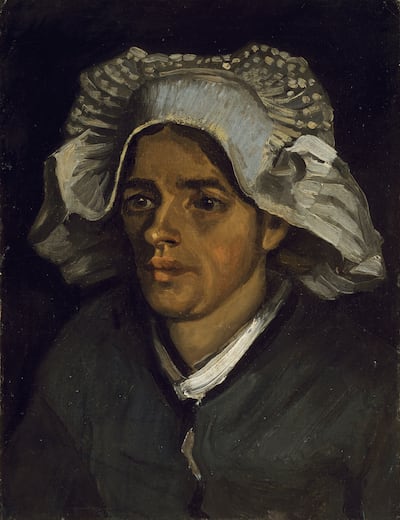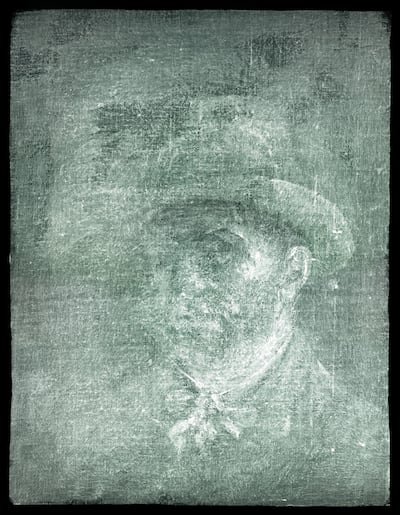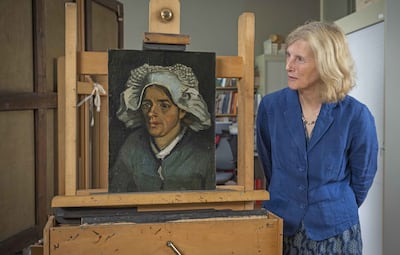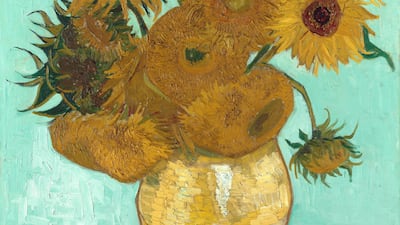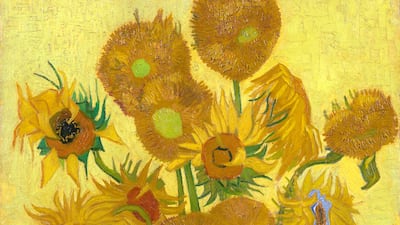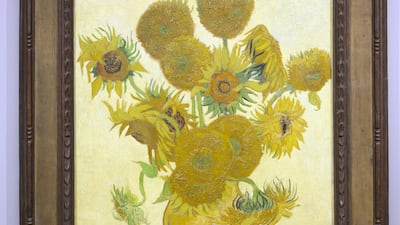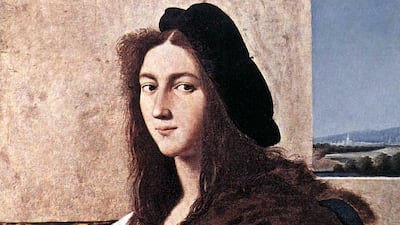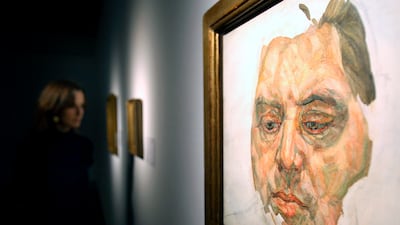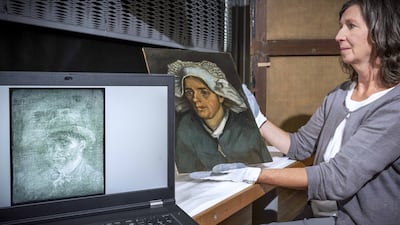A painting that is "most certainly" a previously unknown self-portrait of Vincent Van Gogh has been discovered by the National Galleries of Scotland.
The extraordinary find is believed to be a first for a UK institution and was discovered by an X-ray taken of Van Gogh's Head of a Peasant Woman (1885) ahead of the forthcoming exhibition A Taste for Impressionism at the Royal Scottish Academy, Edinburgh.
Hidden from view for over a century, the portrait was found on the back of the canvas with Head of a Peasant Woman, covered by layers of glue and cardboard that are believed to have been applied ahead of an exhibition in the early 20th Century.
Van Gogh was known for reusing canvas to save money by turning it round and working on the opposite side.
The portrait shows a bearded sitter in a brimmed hat with a neckerchief loosely tied at the throat. His left ear, which he famously cut off in 1888, is clearly visible.
It is thought to be from his early work and his first exploration of self-portraits, which he later became known for.
Viewers will be able to see the sketch as an X-ray image through a specially crafted lightbox.
While it may be possible to separate the paintings, the process of removing the glue and cardboard will require delicate conservation work. Research is ongoing as to how that can be done without harming Head of a Peasant Woman.
The discovery has been described as "thrilling" by Professor Frances Fowle, senior curator of French art at the National Galleries of Scotland. She said: "Moments like this are incredibly rare.
"We have discovered an unknown work by Vincent Van Gogh, one of the most important and popular artists in the world.
"What an incredible gift for Scotland, and one that will forever be in the care of the National Galleries. We are very excited to share this thrilling discovery in our big summer exhibition A Taste for Impressionism, where the x-ray image of the self-portrait will be on view for all to see."
Lesley Stevenson, senior paintings conservator at the National Galleries said they are "thrilled to bits" to have discovered the portrait.
"When we saw the X-ray for the first time of course we were hugely excited," she said.
"This is a significant discovery because it adds to what we already know about Van Gogh's life.
"There is lots to think about with regards to the next steps, but for us it is another little nugget to get us a little bit closer to an incredible artist.
"Knowing that it's there in a painting that's in the National Galleries of Scotland in a collection that belongs to the people of Scotland is incredibly important and significant.
"Hopefully it will encourage people to come along and have a look."
Art enthusiasts will be able to view the portrait as part of the exhibition which will take place between July 30 and November 13.
The team
Videographer: Jear Velasquez
Photography: Romeo Perez
Fashion director: Sarah Maisey
Make-up: Gulum Erzincan at Art Factory
Models: Meti and Clinton at MMG
Video assistant: Zanong Maget
Social media: Fatima Al Mahmoud
Specs
Engine: Duel electric motors
Power: 659hp
Torque: 1075Nm
On sale: Available for pre-order now
Price: On request
What are NFTs?
Are non-fungible tokens a currency, asset, or a licensing instrument? Arnab Das, global market strategist EMEA at Invesco, says they are mix of all of three.
You can buy, hold and use NFTs just like US dollars and Bitcoins. “They can appreciate in value and even produce cash flows.”
However, while money is fungible, NFTs are not. “One Bitcoin, dollar, euro or dirham is largely indistinguishable from the next. Nothing ties a dollar bill to a particular owner, for example. Nor does it tie you to to any goods, services or assets you bought with that currency. In contrast, NFTs confer specific ownership,” Mr Das says.
This makes NFTs closer to a piece of intellectual property such as a work of art or licence, as you can claim royalties or profit by exchanging it at a higher value later, Mr Das says. “They could provide a sustainable income stream.”
This income will depend on future demand and use, which makes NFTs difficult to value. “However, there is a credible use case for many forms of intellectual property, notably art, songs, videos,” Mr Das says.
The bio
Studied up to grade 12 in Vatanappally, a village in India’s southern Thrissur district
Was a middle distance state athletics champion in school
Enjoys driving to Fujairah and Ras Al Khaimah with family
His dream is to continue working as a social worker and help people
Has seven diaries in which he has jotted down notes about his work and money he earned
Keeps the diaries in his car to remember his journey in the Emirates
Health Valley
Founded in 2002 and set up as a foundation in 2006, Health Valley has been an innovation in healthcare for more than 10 years in Nijmegen, the Netherlands.
It serves as a place where companies, businesses, universities, healthcare providers and government agencies can collaborate, offering a platform where they can connect and work together on healthcare innovation.
Its partners work on technological innovation, new forms of diagnostics and other methods to make a difference in healthcare.
Its agency consists of eight people, four innovation managers and office managers, two communication advisers and one director. It gives innovation support to businesses and other parties in its network like a broker, connecting people with the right organisation to help them further
How to apply for a drone permit
- Individuals must register on UAE Drone app or website using their UAE Pass
- Add all their personal details, including name, nationality, passport number, Emiratis ID, email and phone number
- Upload the training certificate from a centre accredited by the GCAA
- Submit their request
What are the regulations?
- Fly it within visual line of sight
- Never over populated areas
- Ensure maximum flying height of 400 feet (122 metres) above ground level is not crossed
- Users must avoid flying over restricted areas listed on the UAE Drone app
- Only fly the drone during the day, and never at night
- Should have a live feed of the drone flight
- Drones must weigh 5 kg or less
Company profile
Name: Thndr
Started: October 2020
Founders: Ahmad Hammouda and Seif Amr
Based: Cairo, Egypt
Sector: FinTech
Initial investment: pre-seed of $800,000
Funding stage: series A; $20 million
Investors: Tiger Global, Beco Capital, Prosus Ventures, Y Combinator, Global Ventures, Abdul Latif Jameel, Endure Capital, 4DX Ventures, Plus VC, Rabacap and MSA Capital
UAE Falcons
Carly Lewis (captain), Emily Fensome, Kelly Loy, Isabel Affley, Jessica Cronin, Jemma Eley, Jenna Guy, Kate Lewis, Megan Polley, Charlie Preston, Becki Quigley and Sophie Siffre. Deb Jones and Lucia Sdao – coach and assistant coach.
WORLD'S%2010%20HIGHEST%20MOUNTAINS
%3Cp%3E1.%09Everest%0D%3Cbr%3E2.%09K2%0D%3Cbr%3E3.%09Kangchenjunga%0D%3Cbr%3E4.%09Lhotse%0D%3Cbr%3E5.%09Makalu%0D%3Cbr%3E6.%09Cho%20Oyu%0D%3Cbr%3E7.%09Dhaulagiri%0D%3Cbr%3E8.%09Manaslu%0D%3Cbr%3E9.%09Nanga%20Parbat%0D%3Cbr%3E10.%09Annapurna%0D%3C%2Fp%3E%0A
Past winners of the Abu Dhabi Grand Prix
2016 Lewis Hamilton (Mercedes-GP)
2015 Nico Rosberg (Mercedes-GP)
2014 Lewis Hamilton (Mercedes-GP)
2013 Sebastian Vettel (Red Bull Racing)
2012 Kimi Raikkonen (Lotus)
2011 Lewis Hamilton (McLaren)
2010 Sebastian Vettel (Red Bull Racing)
2009 Sebastian Vettel (Red Bull Racing)
%3Cp%3E%3Cstrong%3EFixtures%3C%2Fstrong%3E%3Cbr%3E%3Cbr%3ESaturday%2C%20May%2028%2C%20United%20States%20v%20Scotland%3Cbr%3ESunday%2C%20May%2029%2C%20United%20States%20v%20Scotland%3Cbr%3ETuesday%2C%20May%2031%2C%20UAE%20v%20Scotland%3Cbr%3EWednesday%2C%20June%201%2C%20UAE%20v%20United%20States%3Cbr%3EFriday%2C%20June%203%2C%20UAE%20v%20Scotland%3Cbr%3ESaturday%2C%20June%204%2C%20UAE%20v%20United%20States%3Cbr%3E%3Cbr%3E%3Cstrong%3EUAE%20squad%3A%20%3C%2Fstrong%3EAhmed%20Raza%20(captain)%2C%20Chirag%20Suri%2C%20Muhammad%20Waseem%2C%20Vriitya%20Aravind%2C%20CP%20Rizwan%2C%20Basil%20Hameed%2C%20Rohan%20Mustafa%2C%20Kashif%20Daud%2C%20Karthik%20Meiyappan%2C%20Zahoor%20Khan%2C%20Junaid%20Siddique%2C%20Alishan%20Sharafu%2C%20Akif%20Raja%2C%20Rahul%20Bhatia%3Cbr%3E%3Cbr%3E%3Cstrong%3ETable%3C%2Fstrong%3E%3Cbr%3E1.%20Oman%2032%2019%2011%2040%20%2B0.156%3Cbr%3E2.%20Scotland%2016%2011%203%2024%20%2B0.574%3Cbr%3E3.%20UAE%2018%2010%206%2022%20%2B0.22%3Cbr%3E4.%20Namibia%2014%207%207%2014%20%2B0.096%3Cbr%3E5.%20United%20States%2016%207%209%2014%20-0.229%3Cbr%3E6.%20Nepal%2012%206%206%2012%20%2B0.113%3Cbr%3E7.%20Papua%20New%20Guinea%2020%201%2019%202%20-0.856%3C%2Fp%3E%0A
Apple%20Mac%20through%20the%20years
%3Cp%3E1984%20-%20Apple%20unveiled%20the%20Macintosh%20on%20January%2024%3Cbr%3E1985%20-%20Steve%20Jobs%20departed%20from%20Apple%20and%20established%20NeXT%3Cbr%3E1986%20-%20Apple%20introduced%20the%20Macintosh%20Plus%2C%20featuring%20enhanced%20memory%3Cbr%3E1987%20-%20Apple%20launched%20the%20Macintosh%20II%2C%20equipped%20with%20colour%20capabilities%3Cbr%3E1989%20-%20The%20widely%20acclaimed%20Macintosh%20SE%2F30%20made%20its%20debut%3Cbr%3E1994%20-%20Apple%20presented%20the%20Power%20Macintosh%3Cbr%3E1996%20-%20The%20Macintosh%20System%20Software%20OS%20underwent%20a%20rebranding%20as%20Mac%20OS%3Cbr%3E2001%20-%20Apple%20introduced%20Mac%20OS%20X%2C%20marrying%20Unix%20stability%20with%20a%20user-friendly%20interface%3Cbr%3E2006%20-%20Apple%20adopted%20Intel%20processors%20in%20MacBook%20Pro%20laptops%3Cbr%3E2008%20-%20Apple%20introduced%20the%20MacBook%20Air%2C%20a%20lightweight%20laptop%3Cbr%3E2012%20-%20Apple%20launched%20the%20MacBook%20Pro%20with%20a%20retina%20display%3Cbr%3E2016%20-%20The%20Mac%20operating%20system%20underwent%20rebranding%20as%20macOS%3Cbr%3E2020%20-%20Apple%20introduced%20the%20M1%20chip%20for%20Macs%2C%20combining%20high%20performance%20and%20energy%20efficiency%3Cbr%3E2022%20-%20The%20M2%20chip%20was%20announced%3Cbr%3E2023%20-The%20M3%20line-up%20of%20chip%20was%20announced%20to%20improve%20performance%20and%20add%20new%20capabilities%20for%20Mac.%3C%2Fp%3E%0A
The White Lotus: Season three
Creator: Mike White
Starring: Walton Goggins, Jason Isaacs, Natasha Rothwell
Rating: 4.5/5
Bib%20Gourmand%20restaurants
%3Cp%3EAl%20Khayma%0D%3Cbr%3EBait%20Maryam%0D%3Cbr%3EBrasserie%20Boulud%0D%3Cbr%3EFi'lia%0D%3Cbr%3Efolly%0D%3Cbr%3EGoldfish%0D%3Cbr%3EIbn%20AlBahr%0D%3Cbr%3EIndya%20by%20Vineet%0D%3Cbr%3EKinoya%0D%3Cbr%3ENinive%0D%3Cbr%3EOrfali%20Bros%0D%3Cbr%3EReif%20Japanese%20Kushiyaki%0D%3Cbr%3EShabestan%0D%3Cbr%3ETeible%3C%2Fp%3E%0A
'My Son'
Director: Christian Carion
Starring: James McAvoy, Claire Foy, Tom Cullen, Gary Lewis
Rating: 2/5
Ibrahim's play list
Completed an electrical diploma at the Adnoc Technical Institute
Works as a public relations officer with Adnoc
Apart from the piano, he plays the accordion, oud and guitar
His favourite composer is Johann Sebastian Bach
Also enjoys listening to Mozart
Likes all genres of music including Arabic music and jazz
Enjoys rock groups Scorpions and Metallica
Other musicians he likes are Syrian-American pianist Malek Jandali and Lebanese oud player Rabih Abou Khalil
